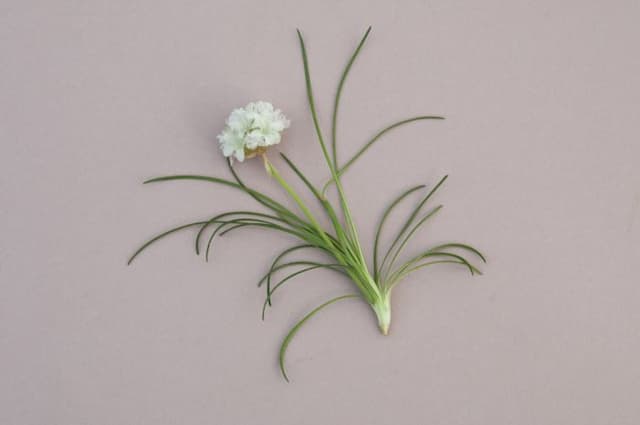Thrift Armeria maritima 'Düsseldorfer Stolz'

ABOUT
Armeria maritima 'Düsseldorfer Stolz', commonly known as sea thrift or sea pink, is a compact, evergreen perennial that forms a dense, cushion-like mound. Its grass-like, dark green foliage emerges in clumps, providing a lush backdrop for the bright, globe-shaped flower heads. These blooms stand proudly above the foliage on stiff, upright stems, resembling small, rounded pom-poms. The flowers are typically a deep rosy-pink color and create a striking contrast against the greenery below. As a cultivar of sea thrift, 'Düsseldorfer Stolz' is particularly prized for its vibrant floral display and tidy habit, which makes it a popular choice for rock gardens, borders, and as ground cover. Its charming appearance is accentuated when planted in large groups, creating a striking swath of color when in bloom.
About this plant
 Names
NamesFamily
Plumbaginaceae
Synonyms
Thrift, Sea Pink, Sea Thrift, Marsh Daisy, Dusseldorf Pride
Common names
Armeria maritima 'Düsseldorf Pride', Armeria maritima 'Dusseldorf Pride'.
 Toxicity
ToxicityTo humans
Commonly known as thrift or sea pink, Armeria maritima 'Düsseldorfer Stolz' is not known for being toxic to humans. However, no plant should ever be consumed unless it is known to be safe for ingestion. If any part of a plant not typically used for food is ingested and adverse symptoms are observed, it is important to seek medical attention.
To pets
Thrift or sea pink, the common name for Armeria maritima 'Düsseldorfer Stolz', is not known to be toxic to pets. However, as with all plants, it is generally recommended to prevent pets from consuming non-food plants to avoid any potential digestive upset. If you suspect that your pet has ingested any part of the plant and is showing signs of distress, consult with a veterinarian.
 Characteristics
CharacteristicsLife cycle
Perennials
Foliage type
Evergreen
Color of leaves
Green
Flower color
Pink
Height
6 inches (15 cm)
Spread
1 foot (30 cm)
Plant type
Herb
Hardiness zones
4
Native area
Europe
Benefits
 General Benefits
General Benefits- Enhances Landscape Aesthetics: Adds a bright splash of color with its vibrant pink to deep rose flowers.
- Drought Resistance: Once established, it has good tolerance to dry conditions, requiring minimal water.
- Low Maintenance: Needs little care beyond occasional watering and the removal of spent flowers.
- Attracts Pollinators: The blooms attract butterflies and bees, promoting biodiversity.
- Coastal Tolerance: As a seaside plant, it can withstand salt spray and is ideal for coastal gardens.
- Compact Growth: Its small, mounded form is suitable for rock gardens, borders, or as ground cover.
- Frost Tolerant: It can survive cold temperatures, making it suitable for gardens in cooler climates.
- Long Blooming Season: Offers extended periods of blooming from late spring to early summer.
- Deer Resistant: Less likely to be eaten by deer, which can be beneficial in areas where deer foraging is an issue.
- Rapid Growth: Quickly reaches its full size, making it a rewarding choice for new gardens or filling in spaces.
- Erosion Control: Its dense root system helps stabilize soil on slopes or in areas prone to erosion.
- Edging Plant: Ideal for defining the edges of paths and garden beds due to its tidy, compact habit.
- Soil Versatility: Adapts to a range of soil types, though it prefers well-drained conditions.
- Evergreen Foliage: Provides year-round greenery, even when not in bloom, due to its foliage.
 Medical Properties
Medical PropertiesThis plant is not used for medical purposes.
 Air-purifying Qualities
Air-purifying QualitiesThis plant is not specifically known for air purifying qualities.
 Other Uses
Other Uses- Sea Thrift can be used in terrariums or miniature fairy gardens due to its low-growing, dense nature, providing a grassy or tufted aesthetic.
- Sea Thrift can be used as a natural dye for fabrics, yielding colors from pink to light purple depending on the mordant used.
- Dried Sea Thrift flowers can serve as decorative elements in dry floral arrangements or wreaths due to their prolonged color retention and structure.
- Sea Thrift is suitable for planting in crevices of rock walls or rock gardens, helping to stabilize the soil and add visual interest.
- This plant can be used as a natural border for coastal gardens, as it is salt-tolerant and can thrive in challenging seaside conditions.
- In eco-friendly landscaping, Sea Thrift is used for xeriscaping, needing less water once established and thus conserving water resources.
- Sea Thrift's tendency to form neat mounds makes it an excellent option for knot gardens, where it provides contrast and structure without aggressive spreading.
- Due to its compact growth habit, Sea Thrift can be planted in green roofing projects as it can withstand the harsh, exposed conditions of rooftop gardens.
- Its resistance to deer browsing makes Sea Thrift a practical choice for areas where deer are a common garden nuisance.
- Sea Thrift can be used in educational gardens to demonstrate plant adaptation to different environments, including saline and sandy soils typical of coastal areas.
Interesting Facts
 Feng Shui
Feng ShuiThe Thrift is not used in Feng Shui practice.
 Zodiac Sign Compitability
Zodiac Sign CompitabilityThe Thrift is not used in astrology practice.
 Plant Symbolism
Plant Symbolism- Resilience: Armeria maritima, commonly known as thrift or sea pink, often grows in challenging coastal conditions, symbolizing the ability to endure and thrive in difficult environments.
- Adaptability: Thrift's ability to grow in poor soil is reflective of adaptability and the capacity to survive with minimal resources.
- Conservation: As a plant that features in coastal and maritime ecosystems, thrift can symbolize the importance of conserving natural habitats and biodiversity.
- Beauty in Simplicity: With its compact growth and delicate pink blooms, thrift exemplifies beauty in simplicity, suggesting that one doesn't need opulence to be beautiful.
- Humility: Despite its tough nature, thrift is a small and unassuming plant, often symbolizing humility and modesty.
 Water
WaterSea Thrift, or Armeria maritima 'Düsseldorfer Stolz', should be watered deeply once a week during its growth period, particularly in the absence of rainfall. Allow the soil to dry out between watering sessions to prevent root rot. The watering frequency may be reduced during the dormant season. Generally, a half-gallon of water per plant is sufficient for each watering session, ensuring moisture reaches the root zone without leaving the soil waterlogged. Adjustments may be needed based on climate, soil type, and weather conditions.
 Light
LightSea Thrift thrives best in full sunlight, making it ideal for a spot that receives at least six hours of direct sunlight each day. This plant is used to coastal conditions, so it can tolerate some wind and salt spray. However, it should be protected from intense, scorching afternoon sun if you live in a particularly hot climate.
 Temperature
TemperatureSea Thrift is resilient to a range of temperatures, able to survive in conditions as cold as 10 degrees Fahrenheit in winter and as warm as 80 degrees Fahrenheit in summer. Ideally, it prefers a coastal climate that remains within the 60 to 75 degrees Fahrenheit range. This plant is hardy and can withstand occasional temperature fluctuations outside these ranges.
 Pruning
PruningSea Thrift benefits from pruning to remove spent flower stems and to promote a compact growth habit. Trim back the faded flowers right after they bloom, which is typically in late spring or early summer. Pruning can help encourage a second bloom and prevent the plant from self-seeding excessively.
 Cleaning
CleaningAs needed
 Soil
SoilThrift (Sea Pink) prefers well-drained soil, with a mix of sand, loam, and organic matter. Aim for a soil pH of 6.0 to 7.5.
 Repotting
RepottingSea Pinks rarely need repotting and thrive in the same spot for several years, unless they outgrow their container.
 Humidity & Misting
Humidity & MistingSea Pink tolerates a wide range of humidity levels and does well in average atmospheric conditions.
 Suitable locations
Suitable locationsIndoor
Place in bright light, water sparingly, and ensure good air circulation for Thrift.
Outdoor
Full sun, well-draining soil, and protection from extreme winter wet for Thrift.
Hardiness zone
4-8 USDA
 Life cycle
Life cycleArmeria maritima 'Düsseldorfer Stolz', commonly known as Thrift or Sea Pink, begins its life cycle as a seed, which, when sown in spring or autumn, germinates in a moist, well-drained environment. As a perennial, once the seedling establishes itself, it enters a growth phase where it forms a dense mound of grass-like foliage. During late spring to early summer, it produces globular flower heads on erect stems that rise above the foliage and are usually a vibrant pink color. After flowering, the plant sets seed, which can be collected for propagation or left to self-seed in favorable growing conditions. Throughout the year, the foliage remains evergreen, adding consistent color to the landscape. With each passing season, the Thrift clump expands slowly, often needing division every few years to maintain its vigor and prevent overcrowding.
 Propogation
PropogationPropogation time
Spring to early summer
The common name for Armeria maritima 'Düsseldorfer Stolz' is Thrift or Sea Pink, and one popular method of propagation is by division. The best time for dividing these plants is either in early spring or after the blooming period in early summer. To propagate by division, carefully lift the clump from the ground and use a sharp knife to divide it into smaller sections, making sure that each section has at least one growing point. Replant the divisions at the same depth they were growing before, spacing them about 12 inches (approximately 30 centimeters) apart to allow adequate room for growth. Water the new divisions well to help establish them. This method is effective and preserves the characteristics of this specific cultivar.
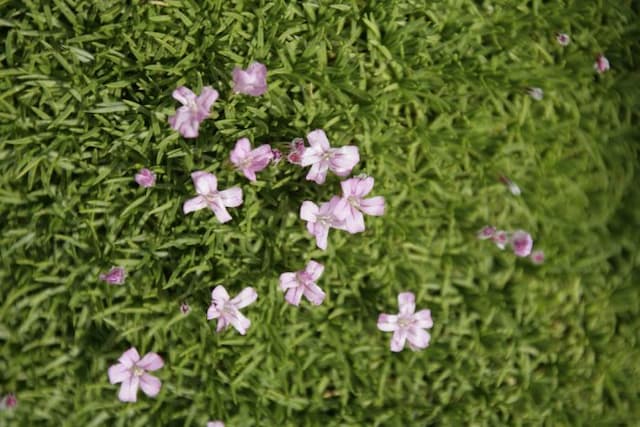
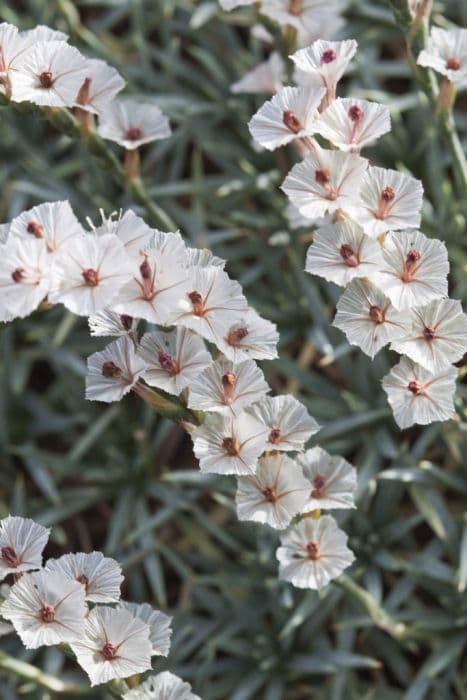
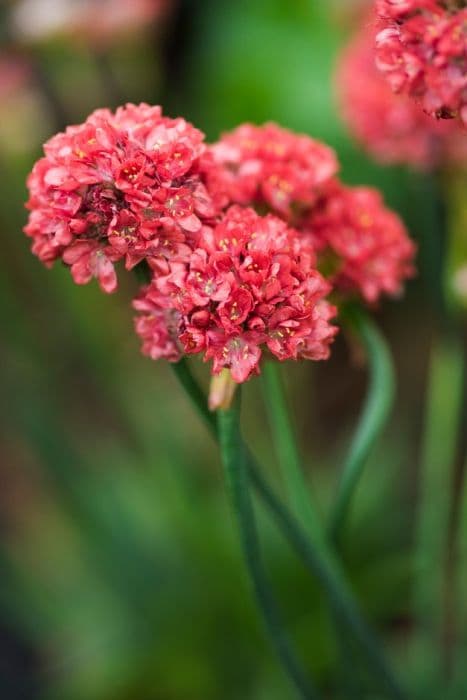
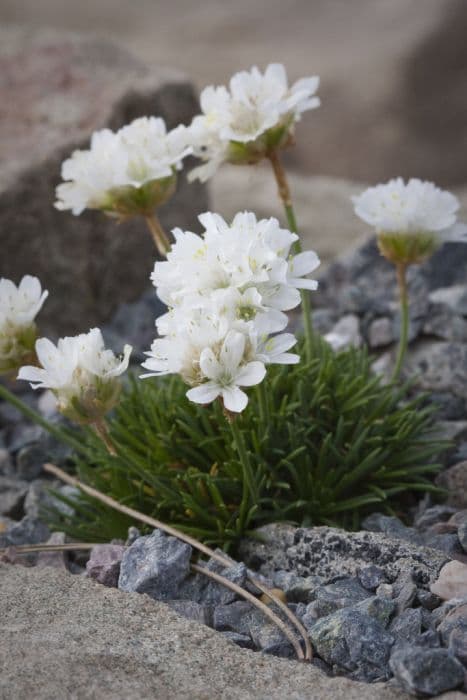


![Chinese plumbago [Forest Blue]](/_next/image?url=https%3A%2F%2Fplants-admin.emdemapps.com%2Fimages%2Fplants%2F%2Fimages%2F604b5c4db911f.png&w=640&q=75)


